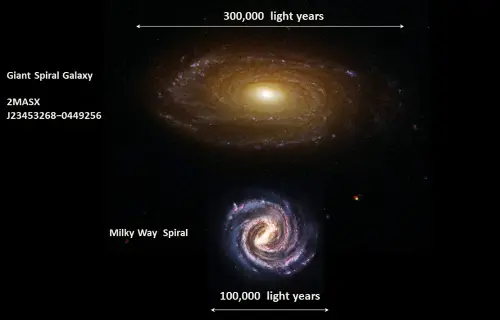
Astrophysicists have teased a hellish potential future in which life on Earth is extinguished by deadly radiation from the supermassive black hole at the heart of the Milky Way.
The picture of a frightening possible fate has been painted by an international team of researchers who studied a very unusual spiral galaxy with the catchy name "2MASX J23453268−0449256" that is challenging our understanding of galactic evolution.
Some three times the size of our Milky Way, the galaxy lies nearly a billion years away from us. The team found that 2MASX J23453268−0449256 sports a supermassive black hole larger than thought possible for any spiral galaxy.
In addition, the black hole is powering colossal jets of superheating plasma that stretch out some 6 million light-years across.
This discovery raises the risk that the Milky Way's central black hole—Sagittarius A*—might end up producing similar jets in the future, with the cosmic-, gamma- and X-rays from such having the potential to cause a mass extinction on Earth.
"This discovery is more than just an oddity—it forces us to rethink how galaxies evolve and how supermassive black holes grow in them and shape their environment," paper author and radio astrophysicist professor Joydeep Bagchi of India's Christ University said in a statement.
"If a spiral galaxy can not only survive but thrive under such extreme conditions, what does this mean for the future of galaxies like our own Milky Way? Could our galaxy one day experience similar high-energy phenomena that will have serious consequences for the survival of precious life in it?"
In their study, Bagchi and colleagues analyzed the structure and evolution of 2MASX J23453268−0449256 using data gathered by the Atacama Large Millimeter Array (ALMA) in Chile, the Giant Metrewave Radio Telescope in India and the Hubble Space Telescope.
They found that the galaxy has an enormous supermassive black hole at its core—weighing in at a whopping billion times the mass of the sun—firing off radio jets that are among the largest known for any spiral galaxy.
Astrophysicists have long thought the violent activity of such colossal black hole jets would disrupt the structure of a spiral galaxy. In fact, previously, such extreme jets had only ever been observed in spiral galaxies.
Despite this, 2MASX J23453268−0449256 seems unflustered by its central behemoth, retaining its structure of well-defined arms, a bright nuclear bar and a surrounding "stellar ring" of dust and stars.
The extreme black hole is not the only unusual feature of 2MASX J23453268−0449256, however—with the team also reporting that it is surrounded by a vast halo of hot, X-ray-emitting gas which is suppressing star formation.
The galaxy has also been estimated to contain 10 times more dark matter than the Milky Way is believed to—material crucial for the stability of its fast-spinning disc.
Put together, the findings open new frontiers in astrophysics and cosmology, the researchers said.
"Understanding these rare galaxies could provide vital clues about the unseen forces governing the universe—including the nature of dark matter, the long term fate of galaxies and the origin of life," paper co-author and astrophysicist Shankar Ray, also of Christ University, said in a statement. "Ultimately, this study brings us one step closer to unravelling the mysteries of the cosmos, reminding us that the universe still holds surprises beyond our imagination."
Sagittarius A*—the supermassive black hole at the heart of the Milky Way—is presently in a dormant state, although astronomers believe that it did have large-scale radio jets in the past.
This could change, the researchers explain, if Sagittarius A* were to pull in and tear apart a gas cloud, star or even a small dwarf galaxy.
These so-called "tidal disruption events" have been witnessed taking place at the cores of other galaxies, but never at the heart of the Milky Way.
If one was to occur around Sagittarius A* and jets were triggered, their impact would depend on their direction, energy output and strength, the team said.
Were a jet to be pointed in the direction of our solar system, it could potentially strip away planetary atmospheres, damage DNA, increase the rate of potentially harmful mutations and even degrade the ozone layer, possibly leading to a mass extinction event.
Do you have a tip on a science story that Newsweek should be covering? Do you have a question about supermassive black holes? Let us know via [email protected].
Reference
Bagchi, J., Ray, S., Dhiwar, S., Pandge, M. B., Dabhade, P., Barth, A. J., Ho, L. C., Mirakhor, M. S., Walker, S. A., Nesvadba, N., Combes, F., Fabian, A., & Jacob, J. (2025). Unveiling the bulge–disc structure, AGN feedback, and baryon landscape in a massive spiral galaxy with Mpc-scale radio jets. Monthly Notices of the Royal Astronomical Society, 538(3), 1628–1652. https://doi.org/10.1093/mnras/staf229
Related Articles
- Our Universe Was Born With 'Anti-Universe' Twin, Claims Physicist
- Largest Ever Map Could Change What We Know About the Universe's Fate
- 'Space Tornadoes' Discovered Swirling Around Milky Way's Central Black Hole
